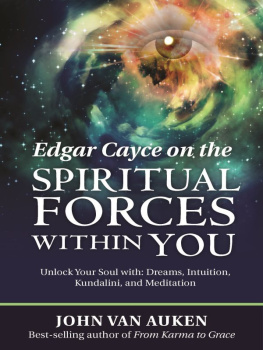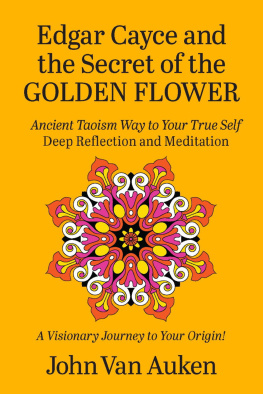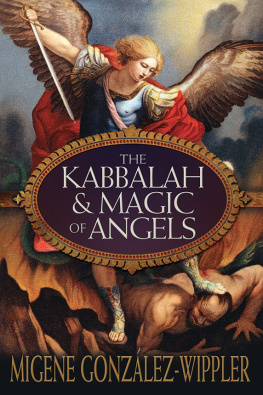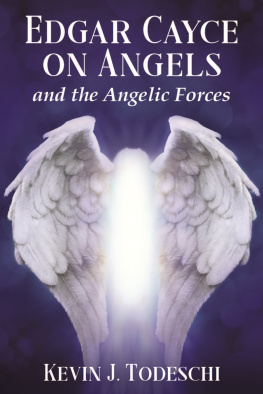EDGAR CAYCE
AND THE
KABBALAH

EDGAR CAYCE
AND THE
KABBALAH

A Resource for Soulful Living
JOHN VAN AUKEN

Copyright 2010
by John Van Auken
2nd Printing, April 2010
Printed in the U.S.A.
All rights reserved. No part of this book may be reproduced or transmitted in any form or by any means, electronic or mechanical, including photocopying, recording, or by any information storage and retrieval system, without permission in writing from the publisher.
A.R.E. Press
215 67th Street
Virginia Beach, VA 234512061
ISBN13: 9780876045695 (trade paper)
Edgar Cayce Readings 1971, 19932007
by the Edgar Cayce Foundation.
All rights reserved.
Original Illustrations by the Author
Cover design by Frame25 Productions
Contents
PART The Essentials
CHAPTER KABBALAH AND CAYCE HIGHLIGHTS

From a human perspective, the information you are about to read is perplexing. It does not fit with the evolution of matter. It does not fit with the visible universe. It does not even fit with much of what we know about ourselves. And yet it is a story that has been with humankind since the most ancient of times. It is a story of humanity that humans have treasured. They have guarded it for millennia, occasionally risking their lives to keep it alive. They have passed it along from generation to generation, as one would a most valuable family heirloom. Elements of this story can be found among people around the world. All people have their version of this story.
Now some will say that the ancient origin of these teachings causes them to be of no value, because everything old is primitive, that our generation is the pinnacle of evolution. They will say that the tales and lore of earlier humans are superstitions. They will say that the ancient ones did not understand the physical laws governing the material universe and the chemistry influencing their bodies and minds.
Some will say that the Kabbalistic version of this story of humanity appeared during a terrible time in human history: the Dark Ages, the medieval period, the dreary Middle Agesa time so filled with plague, inquisition, ignorance, and cultural decline that we may rightly ask how anything coming out of that period could be of value to us. This view overlooks the dating of Kabbalahs ancient sources and the geographical breadth of its recovered remnants of these teachings: from Spain to India, from Turkey to Egypt.
This story is about an invisible universe that exists just behind, closely around, but especially within the visible one we know. It is about a whisper, a whisper in the depths of human consciousness that says, We are more than we appear to be. It says, The origin of our life began long before the physical world. It whispers that there was an involution into matter from realms of energy and dimensions beyond the threedimensional realm. It whispers angels, planes of existence, and reincarnation. It whispers that we are celestial soul minds, only temporarily incarnated in terrestrial bodies, and that we are destined to return to the heavens and nonphysical soul life. Of course, to the materially minded, these ideas are impossible; they dont fit with reality. And yet this soul portion of our being is just on the other side of the thinnest, most subtle veil between human consciousness and soul consciousness. Fortunately, despite the opacity of this veil, the soul and its story slip through from time to time, and humans speak of these ideas again, as they have for ages.
Many feel that they have become better persons for having learned and practiced the wisdom of Kabbalah and that it has made their physical lives more meaningful and fulfilling.
Kabbalah, or Qabalah, comes from the Hebrew word QBLH (there are no vowels in the language), which is derived from the root QBL, meaning to receive but with the nuance to correspond in a manner that is face to faceas Moses received from God and communicated with God face to face, such that his face shone from the experience. (Exodus 34:29) The term is sometimes written Qabalah or Cabala but better reflects its origin and sounding when written in English as Kabbalahpronounced variously as kaballah, kabbalah, and kabalah, although most Westerners pronounce it kaballah, associated with the word cabal (of French origin), meaning a group of persons secretly involved in artifices and intrigue.
Legend holds that Kabbalah was first taught by God to a select group of angels. Then, after the fall of the angels (which is explained in to the wisdom. This may have been the origin of Hermeticism (based on the teachings of the Egyptian god Thoth; in Greek, Hermes), Gnosticism (from the Greek word gnosis, meaning to know), and NeoPlatonism (from a school founded by Plotinus and based on the teachings of Plato and earlier Platonists).
Some may say that Hermeticism, Gnosticism, and NeoPlatonism predate Kabbalah, but the stories, characters, mythology, and motifs in ancient Judaism reach back thousands of years before such similar teachings. Many date Adam and Eve of Genesis to about 4000 BCE; Abraham, 1800 BCE; and Moses, 1500 BCE. The Torah, The Book of the Law, is dated to 1446 BCE. Even so, some separate ancient Mosaic Judaism from Rabbinic Judaism, and Rabbinic Judaism from Kabbalah, which they will only date to the works of medieval writers (from about the seventh century, reaching its peak in the twelfth and thirteenth centuries). Yet major portions of a most important book of the Kabbalah, the Zohar, are attributed to the writings of Rabbi Shimon Bar Yohai, who lived in the 100s! Also, the oldest book of the Kabbalah, Sefer Yetzirah, The Book of Creation, is traditionally ascribed to Abraham! Its actual authorship is uncertain, yet scholars consider it to be at least 2,500 years old.
Another point of uncertainty argues that rabbis of the first and second centuries simply adopted Gnostic teachings to create Kabbalah. However, this is just too uncharacteristic of these men, their lives, and their writings to be the case. These men were raised and deeply studied in the particulars of their own faith and traditions. And even though they were openminded seekers of truth, it is unlikely that they adopted an alien philosophy and its terminology. Rather, it is more likely that there was an enlightened realization that these philosophies and mythologies shared much in common, as did NeoPlatonism and Hermeticism. One of the most convincing arguments to counter the view that rabbis adopted Gnosticism can be found in the book The Impact of the Kabbalah in the Seventeenth Century by Allison P. Coudert (Brill, 1999). Professor Coudert writes:
The frontispiece of the Kabbala denudata [Kabbala Unveiled] shows the high expectations Knorr [Christian Knorr von Rosenroth, 16361689] and van Helmont [Francis Mercury van Helmont, 16141698] had of the Kabbalah in terms of religious peace and unity. It also reveals their conviction that the Kabbalah offered a key to understanding the natural world as well. Here the figure of a beautiful maiden [see illustration 17] with flowing hair and Grecian robes gazes skywards as she runs along a narrow ledge of earth separating the sea from a cave. Her destination is a doorway marked Palatium Arcanorum (Place of Secrets). Intrat (she enters) is written on the threshold of this palace, while the word domat (she calms, subdues) appears under her right foot and alterat (changes for the better, transmutes) under her left. The cave is designated antrum materie (the cave of matter) and within it appear the astrological and alchemical signs that stand for the planets and their comparable metals. In her right hand, which is stretched over the swelling waves, she holds a burning torch, under which is written mare concupscientiarum (the sea of concupiscence) [which, in this context, likely means ardent longing rather than sexual desire]. In her left she carries a scroll representing the Scriptures, on which is written explicat (she explains). A ship sails in the distance; while on the edge of the shore, almost submerged by waves, a tree grows. A great circle of light breaks through the clouds and darkness, and within this light are three circles, which in turn enclose three smaller circles. These stand for the ten kabbalistic sefirot [emanations], or the ten faces
Next page









